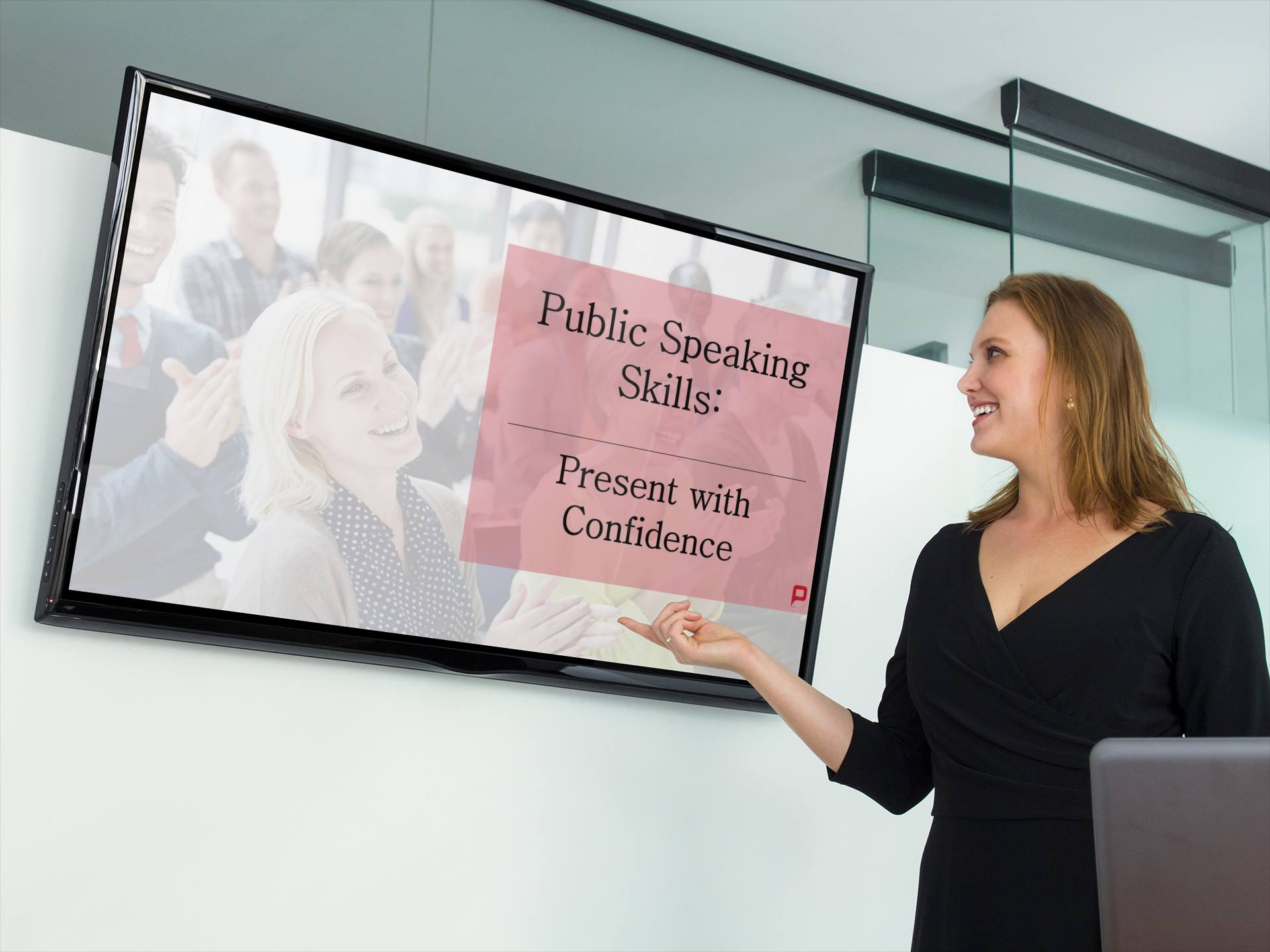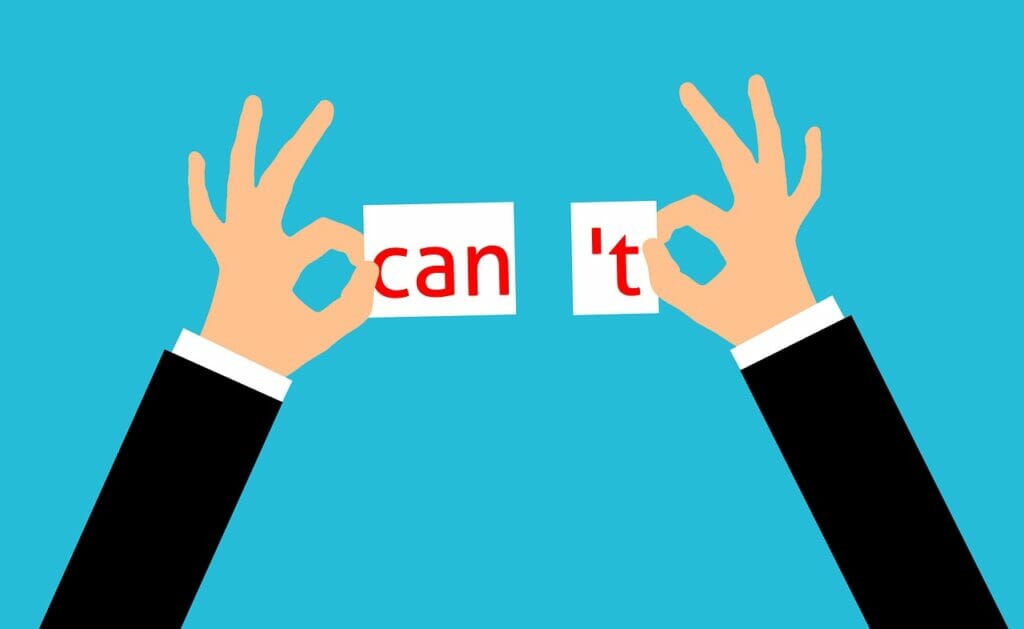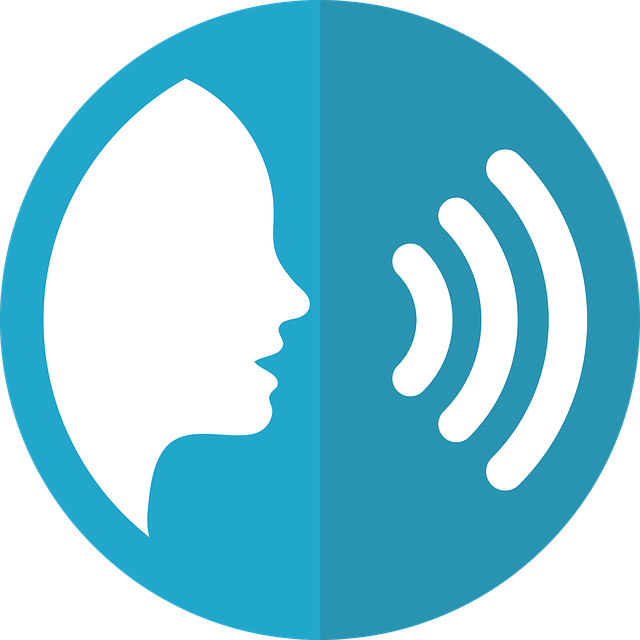
Public Speaking Skills: Present with Confidence
We’ve all come across that person who seems born to speak in public. He or she is totally unfazed by the size of the audience and speaks clearly and persuasively, using language to its best advantage. Then there’s you: more than two pairs of eyes pointed in your direction and you feel yourself falling to bits; your voice cracks with nerves, and you lose the thread every time you look up from your script, which now feels boring and uninspired. Help!
How you use your voice and employ public speaking skills, such as rhetoric (we’ll get to that later), has a huge influence on how your audience receives your presentation. Get it wrong, and you can bore or irritate people.
Get it right, and you can feel them becoming increasingly engaged, hanging on your every word, sympathetic to your message and interested in what you have to say. We’re here to show you how to get it right every time – up your speaking skills game and ace your presentations with confidence and control.
What are speaking skills? What is rhetoric? And how can they add value to your presentations?
The term “rhetoric” is derived from the ancient Greek and translates as oratory or eloquence. In its best form, it is the art of persuasion – using speaking skills to make the flow of speech as appealing as possible to inspire listeners.

Anyone who delivers business presentations should know how to use rhetoric. It’s been around forever and has lost none of its importance today. As a presenter, you have a fundamental responsibility: to convince your audience and, in the best case, to inspire them; because even the best content won’t persuade an audience if it isn’t presented effectively.
Politicians and PR professionals are masters of the art of rhetoric (even if they give it a bad name from time to time by using it in bad faith). There are a few rules which make it easier for you, and we’ll go through those below. Following them can make a huge difference in how your presentation is received.
If you don’t know about these rules, it’s sadly easy to get things wrong when presenting; it happens every day and you may have experienced it yourself. PowerPoint presentations can be overloaded with graphics and short on interest or drag on like chewing gum on the sole of your shoe because the speaker’s voice is so monotonous.
We’ve all found ourselves on the verge of nodding off because a presentation was boring – even though we were there because we found the topic interesting.
So how do you avoid doing the same? Well, the proper use of rhetoric can really help. Apply these proven techniques, tips and tricks and you’ll be able to present your content in a lively and interesting way and keep your audience engaged and entertained.
Such techniques include pauses in speech, body language and the volume and tone of your voice. We’re here to help with some proven techniques, tips and tricks to help you master rhetoric and become a better public speaker than you ever dreamed of.
How do you improve your speaking skills, then?
The simple answer to this is: practice makes perfect. These aren’t completely alien concepts: in a way, we all use speaking skills every day. There are many situations in life where you’ll have needed to communicate freely, confidently and with aplomb, whether in public or in private. So, chances are good that you already have a basic grasp of the speaking skills you need.
Here’s your chance to gain a massive advantage over the competition by learning and practicing this art of persuasion, maximizing the power of your content and engaging your audiences to the full.
Communication: It’s not just what you say, but how you say it
Communication expert Paul Watzlawick states “You cannot not communicate“. Even if you’re not actually saying a word, something is being expressed. Just standing silently is a form of communication, and it also conveys an intention.
An audience unconsciously interprets and evaluates not just the language you use, but also your body language and behavior. You can gain a lot by learning about and improving your own non-verbal communication. This article aims to cover many valuable aspects of your speaking skills, and how you say what you say.
Know your audience
Rhetoric helps you get your key messages across as clearly as possible. Remember to always keep your audience in mind. Both your language and the way you use rhetoric should be tailored to your audience’s particular characteristics, such as age, level of knowledge and professional situation.
Your first step is to get to know your audience. If you use rhetorical devices such as metaphors (like “nailing it” – getting a project or task done) your audience has to be able to understand them.
It’s not just about the content, though. You are important, too. If you get anxious about having to speak in public, you can start by trying to change your own mindset. Sounds too simple but repeating a mantra like “I’ve got this!” over and over again before the presentation really works. The more positive you are, the more confidence you will have in your presentation. Try it!

There are courses which can teach you rhetoric; if you can find one, why not give it a try? You’ll learn just how important it is to get your public speaking skills up to scratch. But it’s perfectly possible to do it yourself. Everyone can master these skills with a bit of practice so keep reading – we’ve got your back!
Speaking skills: the basics
These 13 simple tips will give you a solid foundation for using language and your own body to give the best presentations ever. It has to be said that it really, really pays to practice before you get anywhere near the audience!
1. Stay hydrated. To keep your vocal cords and mouth from drying up, Up your liquid intake (e.g., water or tea) well in advance of your presentation.
2. Get enough vocal rest. If you spend the night before your presentation shouting at a football match or in a loud bar, you’re putting unnecessary strain on your voice for the next day.
3. Stand up straight, with your weight evenly distributed on both feet. Make sure your chest is relaxed and open; if you let it cave in, you can’t make the most of your voice, and you may come across as insecure.
4. Breathe in and out calmly and deeply, feeling your breath fill your chest down to your diaphragm. Practice exhaling for a long time and taking a deep breath before each long sentence, and definitely before starting your presentation. This means you can speak freely, without having to catch your breath in the middle of a sentence.
5. Maintain a natural and relaxed pitch to your voice. Avoid letting your voice get higher when you speak louder or when you’re nervous. Lower pitches are often more comfortable to hear.
6. Record your presentation when you rehearse (yes this is terrifying, but it does pay off!) and listen to the tone of your voice and how you express yourself. Are you speaking too loudly or too softly? Where can you improve? What comes across as confident? Are there any places where you sound unconvincing?
7. Don’t rush your ideas! Take a deep breath after each sentence and make good use of the short pause (see below). This will keep you focused and calm.
8. Watch your speaking speed. Speaking too quickly means your audience won’t catch what you’re saying. The entire point is to be heard and understood. Your message is the focus, and it’s a real shame if your speech obscures that.
9. Speak clearly. Sounds obvious, but it’s easy to mumble or slur your words when nervous. A fun exercise is to practice tongue twisters every now and then, pronouncing them as clearly as possible.
10. Use short sentences. The shorter the sentence, the easier it is to understand. Our brains are designed to focus on one core concept when listening, and longer sentences can decrease that focus. Put the most important statements directly at the beginning of a sentence and emphasize them (e.g., “We generated 3.5 million euros this year. 3.5 million!”).
11. Try not to use too many foreign words: they can seem sophisticated when you write your speech, but quickly lead to many listeners switching off. The average attention span is only 20 minutes, so calibrating the length of your presentation is important.
12. Hum! You can practice finding your own optimal speech volume and voice tone by humming a few times and then going straight to speaking a sentence. This will help you use the most pleasant and persuasive pitch of your voice.
13. Find your groove. Keep your presentation feeling as free and easy as possible.
Try to practice all these tips when you rehearse your presentation. You’ll soon see how much more confident you come across. You’ve started mastering great speaking skills already!

Using rhetoric confidently
You’ve covered the basics. Now it’s time to focus on polishing the content of your presentation. You really need to get your audience on board right at the start. Beginning awkwardly makes a bad impression, and that’s difficult to salvage. There are a few things you can use here to create the perfect introduction to captivate your audience and continue with confidence. They include:
Surprise!! Starting off with a surprise will grab your audience from the get-go. Everyone expects the usual phrases (“Thank you for coming today”), so if you do something completely unexpected, your audience will sit up and listen. It can help to involve your audience by asking an unexpected or funny question, such as, “So, what’s it going to take to get you all to pay attention throughout my presentation?”
Storytelling: The human brain is wired to pay attention to storytelling. It creates a direct connection with the audience. Personal anecdotes add variety and are a great way to start a presentation. Mixing these with humor or self-deprecation can really grab your audience (“You won’t believe what just happened to me…”).
This presentation technique makes you appear approachable and likeable, on a level with the audience. A few anecdotes throughout the presentation will keep this feeling going.
Questions, questions, questions! As we mentioned above, starting with a question can be really effective. Questions can also be useful during the rest of the presentation. They make your audience feel much more connected with you and your content.
Try including different types of questions in your presentation, such as a leading question (“Aren’t you tired of…?”) or an opinion poll (“So who prefers…?”). Try bookending your presentation with a question at the beginning and again at the end, listening closely to how your audience answers.
Exaggeration: Starting with your key message is a given. But if you just drop it in and move on, it can get lost. One interesting tactic is to exaggerate it to the extreme (“If you don’t network, you won’t get project orders.”).
This can polarize your audience, but it ensures maximum interest, meaning your audience is now curious about where you’re going, and you have both their attention and a great space for a discussion.
Use rhetoric: Rhetorical devices (we cover these below) can be fantastic right at the beginning of a presentation! Comparisons, similes and metaphors all stimulate your audience to think (e.g., “bull and bear”: rising or falling stock prices).
Your audience starts by being presented with vivid mental images and has to think how you’re applying them. Working this out gives people a sense of achievement, which gives you a positive start to your presentation.
You can find more helpful tips and tricks for the perfect start to your presentation here.
Speaking skills: Rhetoric can give you a huge advantage
Our final point above shows that using rhetoric can captivate your audience from the start, meaning your presentation is far more likely to be a success. But it’s not just the intro which can benefit; peppering your presentation with the occasional rhetorical device adds spice and interest throughout. They can also help to turn a complicated concept into something simpler and easier for your audience to understand.
Don’t go overboard, though; using too much rhetoric in your presentation can make you come across as pompous and unapproachable.
There are many elements of rhetoric to consider. Here are some of the best:
Alliteration: This is using two or more words that start with the same sound. It’s a great way to grab people’s attention (e.g., “Potential PowerPoint plusses . . .”).
Anaphora: Repetition of a word or phrase at the beginning of successive sentences, phrases or clauses. This emphasizes your point while adding an enjoyable rhythm to your speech. A good example of this is Winston Churchill’s speech beginning with, “We shall fight them on the beaches”. He repeated “We shall” and “We shall fight” to great effect.
Antithesis: This is a figure of speech which juxtaposes two contrasting or opposing ideas. It’s an effective technique for stimulating discussion (e.g., “That’s one small step for man, one giant leap for mankind.” – Neil Armstrong).
Hyperbole: This involves generating attention by exaggerating (e.g., “If you don’t network, you won’t work.”)
Climax: a figure of speech in which successive words, phrases, clauses or sentences are arranged in ascending order of importance (e.g., “What started as a glitch evolved into a product that turned out to be a bestseller.”).
Metaphor: this a figure of speech that is used to make a comparison between two things that aren’t alike but do have something in common. They create strong images, which can leave a lasting impression (e.g., “Creating PowerPoint presentations is a breeze!”) Further information and examples of metaphors can be found here.
Neologism: This basically means making up a new word, which can amuse and interest your audience! An example might be, “PowerPointers” for tips on how to best use this Microsoft application. Make sure they’re not too abstract; your new word still needs to make sense.
Parallelism: this means balancing two or more ideas or arguments that are equally important (e.g., “Give a man a fish, feed him for a day. Teach a man to fish and feed him for life.”). It makes your speech more vivid and therefore more memorable.
Your voice: An important element of your presentation

Your voice is a hugely important part of your speaking skills. Studies show that the sound of a person’s voice is up to three times more important than what that person is actually saying! Getting to know how to use your voice to its best will really add to your speaking skills and massively increase the impact of your presentations.
Voice use covers various aspects, such as pitch, tone, volume and stamina. Working on all of these can give you a huge advantage when presenting. Again, there are courses you can take to improve your vocal speaking skills, but it’s perfectly possible to work on them on your own – here are a few tips:
Vary the rhythm of your voice. One of the worst mistakes you can make is to speak in a monotonous tone and rhythm. Your audience will soon fall asleep (or wish they could). Varying the speed of your words to complement what you’re saying, keeps interest in your content alive. You can use this to draw attention to particularly important concepts.
Don’t babble. Most people tend to speak too quickly when they’re nervous, meaning the audience catches maybe half of what was said. A deep breath before you speak and being conscious of the tempo of your voice, should solve this.
Pay attention to pitch. Our voices have a natural speaking pitch (e.g., how high or low we speak). This is determined by our individual physiology. We are naturally at our most persuasive, and perceived as most honest, when we find it. Societal pressures, and the nerves we can feel when speaking in public, often force our pitch higher, giving us an inauthentic, and uneasy sounding voice.
It helps to be aware of this and find a more natural voice pitch. This has a pleasant effect and radiates competence. By taking deeper breaths and speaking more slowly and consciously, you can avoid pitching your voice too high. Listening back to a recording can really help here, too.
Emphasis. People often only emphasize nouns when delivering presentations. Why not try emphasizing verbs more often? They naturally stimulate the brain and make your speech more interesting to listen to.
Breathing. Excitement, or nerves, can cause you to gasp for air. The solution is to breathe deeply into your belly, allowing yourself time to do so. If you notice that you’re running out of breath, take a short break, breathe deeply and then carry on.
The power of the pause

Pauses are a simple but extremely effective tool for building tension and keeping presentations lively and interesting. Get them wrong, however, and you can come across as unsure of yourself or nervous. Here are a few ways to use pauses properly:
Pause for emphasis. Taking a pause after a key statement or fact emphasizes the importance of what you’ve just said, allowing your audience to focus and remember your key points. It’s important not to interrupt the flow of speech for too long, as this ends up being very distracting and uncomfortable for your audience.
This sort of pause should be used sparingly (three to four times at most per presentation), otherwise it loses its effect.
Pause for confidence. If you feel at any point that your confidence is flagging, or that your presentation is not going so well, take a short break to regain your composure. This gives you an opportunity to regroup your thoughts and continue with renewed vigor.
Such pauses should be kept short so as not to unsettle the audience or show your own uncertainty. But remember that time feels different when you’re presenting; timing your pauses in rehearsal and listening to the playback is invaluable.
Pause to let information sink in. When presenting, you may notice that your audience tunes out from time to time. This doesn’t mean they aren’t interested in what you have to say. Sometimes, if you’ve presented them with a lot of information, your audience needs a moment of silence to process all the new facts or ideas.
Taking a short break allows your audience the chance to mentally sort out what you’ve just said and refocus on your presentation.
How to avoid filler words
There are those who can speak fluently and eloquently in public, seemingly carefree, able to improvise and adapt effortlessly. That’s not most of us, though! One thing most of us do is to stick in useless, “filler” words – the um’s, the ah’s, the sooooo’s.
They can occasionally help to cover a moment when you’re thinking what to say but use them too often, and you come across as nervous and insecure. A professional, well-thought-out speech doesn’t need filler words.

How do you avoid them? Preparation is the key. Rehearse your speech, warm up your voice beforehand and breathe consciously, slowly and deeply. More great tips for avoiding filler words and giving a fluent, confident presentation can be found here and here.
Use your speaking skills right to the very end
With the help of the above points, you’ll start your presentation strongly and deliver its content to great effect. But don’t drop the ball at the finish! Speaking skills can help you bring your presentation to a successful conclusion; your audience will remember it for a long time to come.
If you opened with a question, revisit it at the end. You can either answer it yourself or better yet, let your audience answer. This direct engagement with your content creates a strong connection with your key messages. You could also try using the rhetorical devices above to bring your presentation to a surprising and refreshing conclusion.
More helpful tips for ending a presentation effectively can be found here.
The bottom line: utilize great speaking skills to present confidently and effectively!
When giving a presentation, the right speaking skills are invaluable. However impactful and sophisticated your PowerPoint slides might be, they will fall flat without the right delivery.
Use our tips to hone your speaking skills, get your key messages across every time and make your presentations livelier and more effective. Consider using some of the rhetorical devices we’ve covered to make your presentations more subtly persuasive. Find your natural speaking voice with our helpful suggestions. And remember: the more practice you put in before your presentation, the better these tips will work. Time spent preparing is never wasted and will serve you well in future presentations.
If you have any questions about specific speaking skills or anything to do with PowerPoint, please don’t hesitate to get in touch at [email protected]. We’re always happy to help!




